
| ICE Case Studies
|
Luisa Reis de Freitas |
I.
Case Background |

The argument that human activity is one of the reasons for climate change is not a consensus among scholars. However, the consequences of the alterations on Earth’s temperature over the last 100 years can be seen and felt all around the world. Temperature increases, sea level rising, changes on dry and rainy seasons are just one of the examples. Being the sixth smaller sovereign state in terms of land and with an average altitude of 1.5 meters, the Maldives Islands are one of the countries most vulnerable to this context. The Maldives’ population will be affected by climate change even with the most skeptical forecast. What I will discuss in this paper is how the Maldivian population will suffer with the consequences of climate changes, specially the sea level rising and will be forced to migrate to other countries, achieving the status of climate refugees and starting a possible context of conflict with the local population of their refuge and will have their sovereignty affected.
Figure 1: The Maldives Island's view from a plane |
2.1 – The Maldives Islands' current situation
As a member of the Alliance of Small Islands States, the Maldives Islands is one of the countries most vulnerable to the consequences of climate changes. This fact is due to the geographical and economic characteristics that the Maldives share with the other members of the AOSIS. They are small portions of land, surrounded by ocean and frequented located in regions that are prone to natural disasters. Besides that, they have poorly developed infrastructures, limited resources and are economically dependent to other countries (Mimura and Nurse. p. 691).
In the specific case of the Maldives Islands the economy and well being of the population is highly dependent on the good conditions of the environment and any change on climate conditions can be dangerous. The tourism is responsible directly and indirectly for a high portion of government revenues (Republic of Maldives, p. 25). Furthermore, 20% of the population depends on fisheries as their major income earning activity (Republic of Maldives, p. 28) all the infrastructure of the islands is at a low elevation of 1.5m above the sea level (Republic of Maldives, p. 24).
 |
Figure 2: One of the Maldive's islands view from the top |
Therefore, any change on the patterns of environment can be seen as a threat to the well being of the Maldivian population. Examples of this are the flood of 1987, which caused damages of US$4.5 million to the Male’ International Airport and the Tsunami in 2004, which affected the tourism sector in US$230 million (Republic of Maldives p. 25). Apart from the structural damage, there are several damages that threat the life of the Maldivian population. The changes on precipitation patterns and flooding caused an increase on diseases, like dengue, shigella and others. Due to changes on temperature and precipitation the Maldivian population now experiences food shortages each year, lasting longer than 10 days (Sovacool, p. 739).
Thus, what we can see is that even though the Maldives Islands, together with the other small islands states, is one of the countries contributes the least to the green house gas emissions, with less than 1% of the global emissions, it is one of the most vulnerable to the effects. Instead of applying its resources to alleviate poverty and improve life conditions, the government is now obliged to use it in projects in order to deal with the climate change consequences (Mimura and Nurse., p. 690).
The discussion about the sea level rise is intense among the scholars. The different ways to analyze the situation lead to a lack of consensus about the actual context and forecast about the relationship about climate change and sea level rise. However, as Woodworth argued in his article “even if the AOGCM(1) modeling is only approximately correct, the Maldives Islands do face an enhanced threat of inundation from a mean sea level rise in this century, exacerbating the existing risks from a range of transient sea level changes in combination with the wave and swell which are the primary causes of erosion” (Woodworth, p. 15).
The figure 1 is a table presented by the IPCC Fourth Assessment Report, launched in 2007. The table shows different scenarios, based on best estimates and likely uncertainty range. The first scenario (B1) is the low scenario, where the best estimate for temperature change is 1.8oC, but the likely range is between 1.1oC and 2.9oC. With this change on temperature, the sea level rise would be around 0.18 cm and 0.38 cm. In the other hand, the last scenario (A1FI) is the worst one, where the best estimate for temperature change is 4.0o C, but the likely range is between 2.4oC and 6.4oC. With this context, the sea level would rise between 0.26 cm and 0.59 cm. However, the report also says that “anthropogenic warming and sea level rise would continue for centuries due to the time scales associated with climate process and feedbacks, even if greenhouse gas concentrations were to be stablish” (IPCC, 2007).
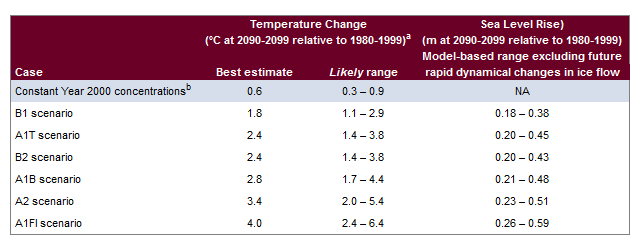 |
Figure 3: IPCC table representing different estimates and scenarios for climate change and sea level rise. |
Thus, what we can conclude after this IPCC Report is that the Maldives Islands will face a challenge in the future even if we stop the greenhouse gas emissions. The worst scenario possible is the complete inundation of the Maldives’ territory, forcing the population to migrate and become climate refugees in other territories, like Australia, India or Sri Lanka. This scenario will lead to a complex situation never seen in the international system before. We will face a situation where we have an entire population inside a country, losing it own territory, culture and sovereignty. What I will argue in the following sections is that this will end up in a conflict situation.
As I explained before, the situation of conflict explained in this case study is based on a forecast of what will happen with the Maldives’ territory and society if the consequences of climate change continue to happen. Thus, it is impossible, at least at this moment, to indicate the exactly duration of the conflict. However, what I can say is that what I see as a solution for this possible conflict is the awareness of the population of the countries who will receive the Maldives’ population, in order to avoid cases of xenophobia.
As we can see on the figure 4, the country is located on the Indian Ocean, at 750 kilometers south from India and Sri Lanka and it is an archipelago formed by 1,190 small tropical islands which 358 are being used for humans’ activities (Republic of Maldives, p. 7) and 200 of them are inhabited (Sovacool, p. 735). The total land area of the country is estimated to be approximately 235 km2 (Republic of Maldives, p. 19). The capital, Malé is 1.7 kilometers long and 0.7 kilometers wide (Sovacool, p. 735) and it is where 104,403 people lives, which is equal to one third of the total population (Republic of Maldives, p. 9).
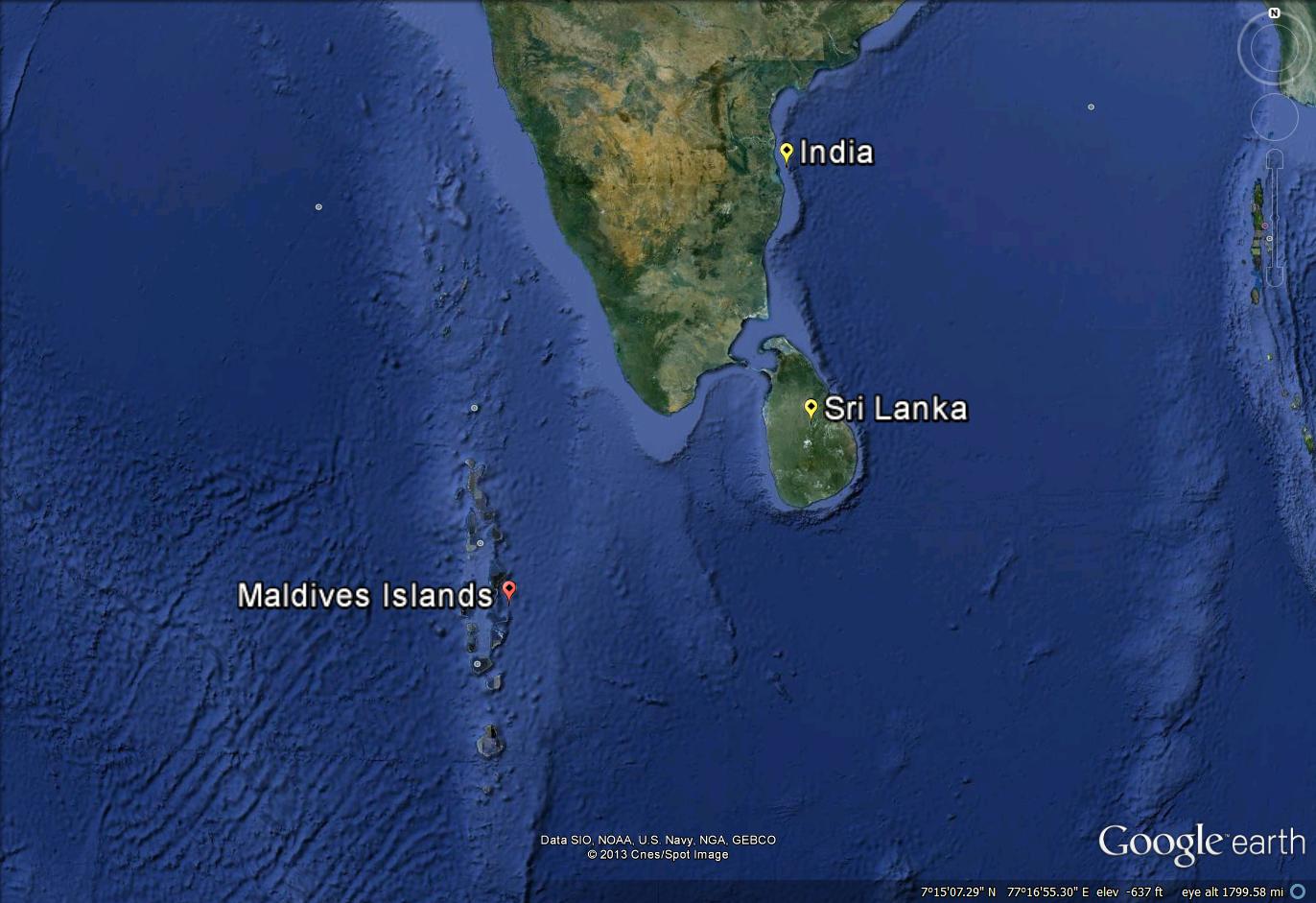 |
Figure 4: Maldives Islands' location |
Given this geographic characteristics, the Maldives’ population and infrastructure is in a vulnerable situation. According to the government, 42% of the population and 47% of all housing structures are within 100m of coastline. Besides that, as we can see on the figure , the Ibrahim Nasir International Airport, for example, has 30% of its structure is within 100m of the coastline and parts of the island is within 15m of the wave break zone (Republic of Maldives, p. 23). This context made the tourism, the major economic activity of the country, vulnerable to any change or alteration on the sea level.
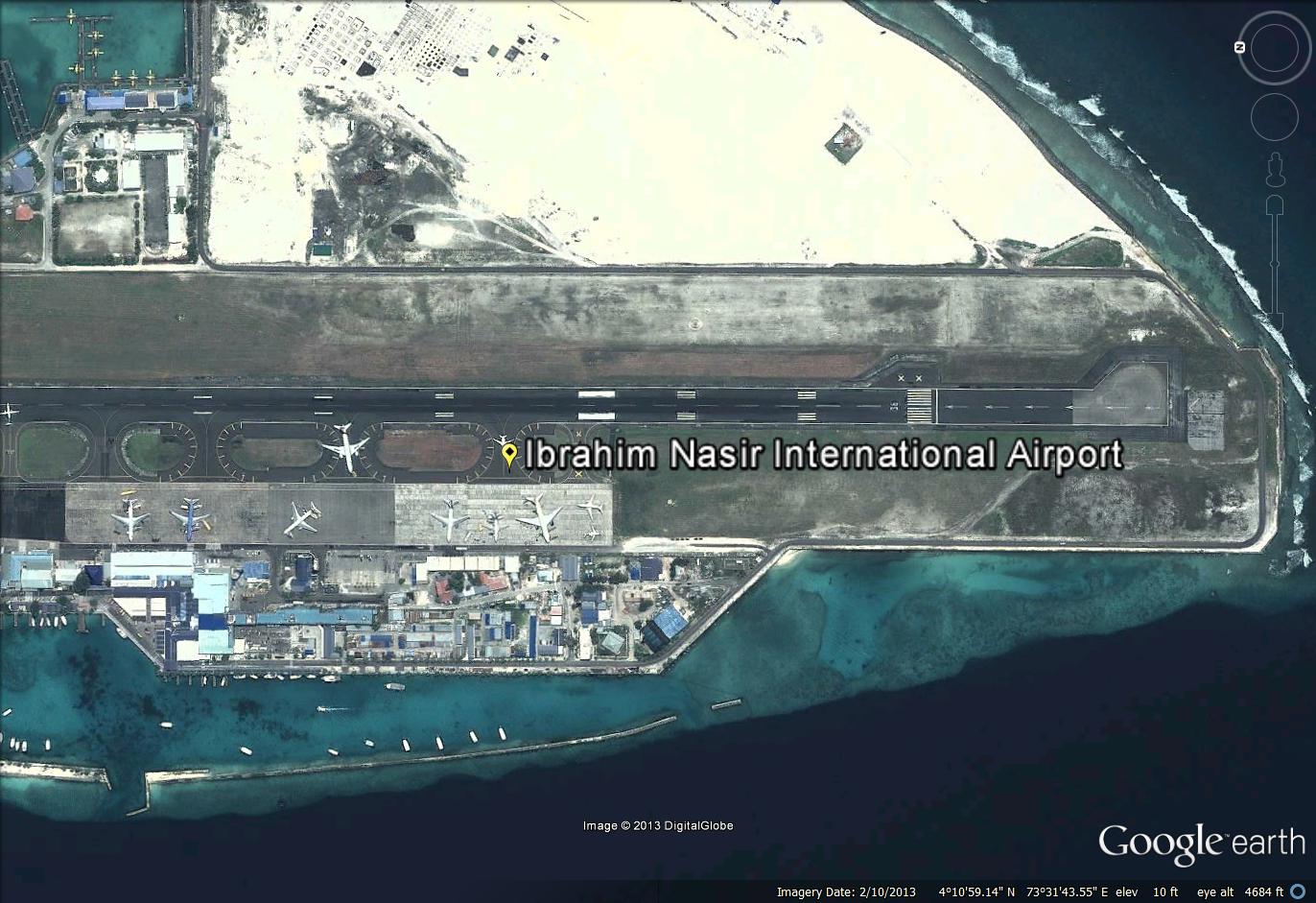 |
Figure 5: Overview from the Ibrahim Nasir International Airport |
The principal actor involved in this situation is the Maldives’ population itself. If the projections made by scholars about the consequences of climate change are correct, the Maldives’ population will be forced to migrate and find another place to live, achieving the label of climate refugees. The Maldives’ president already stated Australia, India and Sri Lanka as possible destinations for his population. Therefore, the local population of these three countries can also be considered as important actors in this context of possible conflict.
However, before the actual displacement of the entire country for one of these territories, there will be many negotiations and discussions within the international community and governments which make them important actors in this situation also. Another important factor in this case is the role of the international agencies and institutions. The United Nations High Commissioner for Refugees and the United Nations itself will play an important role in dealing with the refugees and the conflict situation.

Concerned with the future of the country, the Maldivian government released a study called “National Adaptation Program of Action” which objective is to explain the impacts of climate change in the country and to point some strategies and policies of adaptation. The consequences of climate change listed on the study are:
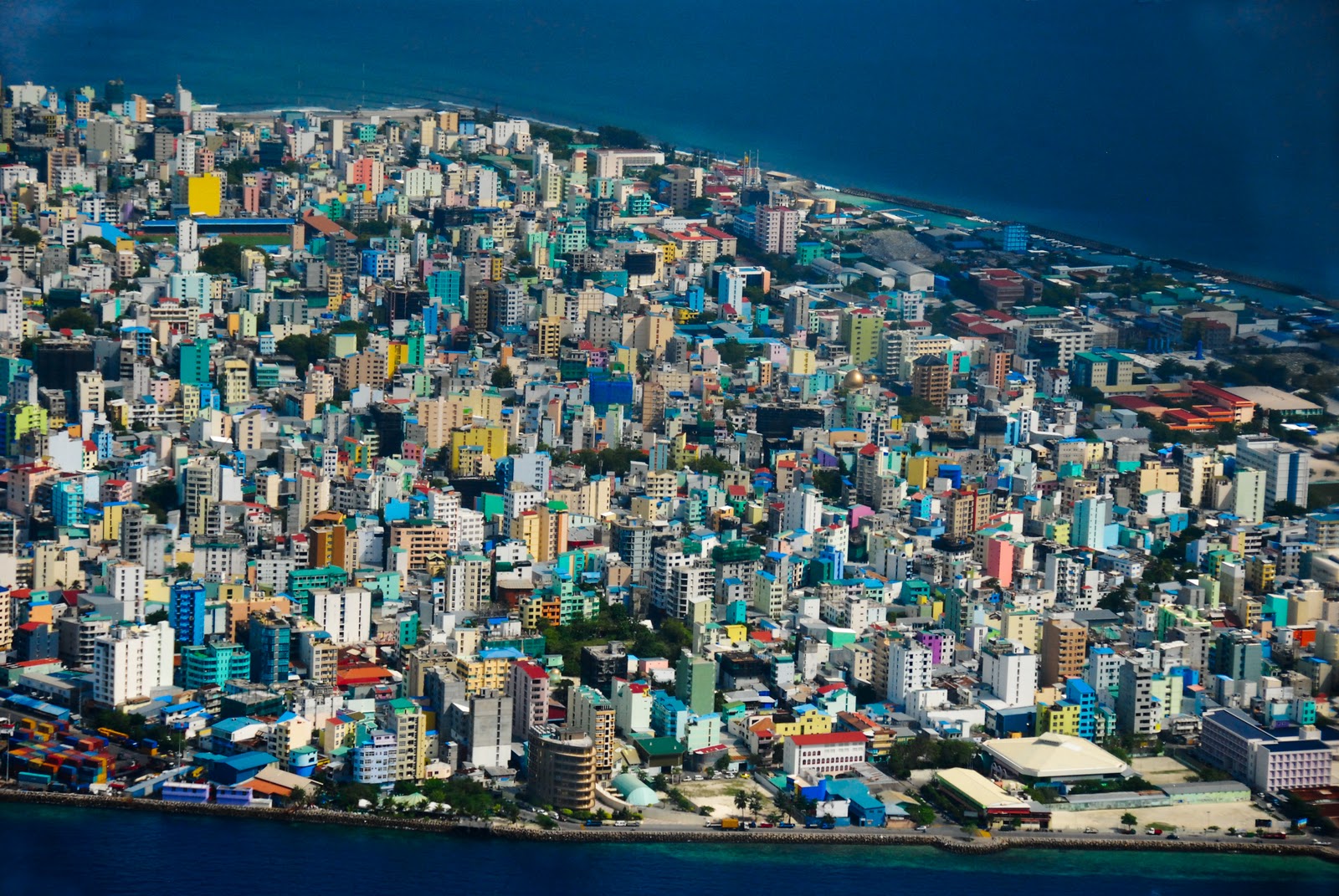 |
Figure 6: The capital, Malé, the fourth most densely populated island in the world |
All of these environmental problems will cause impacts on the Maldives’s population and environment. The study highlighted eight areas that are vulnerable and will be impacted by these effects of climate change. These areas are:
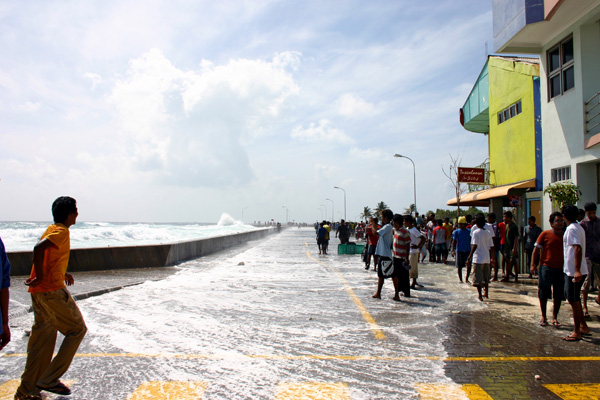 |
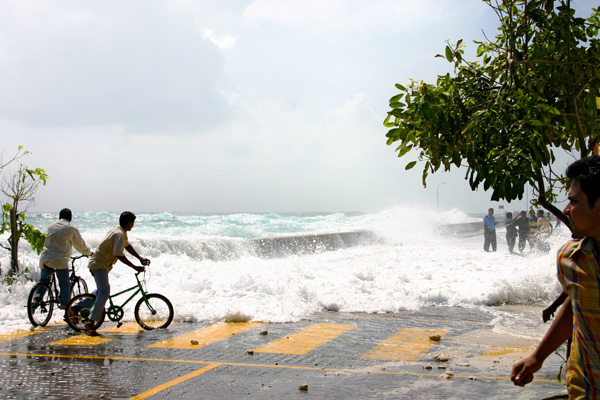 |
Figure 7 and 8: Waves invading the territory of one of the Maldivian Islands |
|
Therefore, the Maldives situation is not only about the sea level rising and the lost of territory. The effects of climate change will appear much sooner than it is expected. The environmental problem is much more comprehensive than the loss of available land and territory. The impacts on the population can be already seen. Over the years the effects will be worse and adaptation measures might not be enough, forcing people to migrate.
Ocean
In the case of the Maldivian situation, the act occurs on the developed countries, which are responsible for the major part of the greenhouse gases emmisions. And the harm occurs on the Maldivian territory, which is vulnerable to any sea level change that might occur due to changes on the world's temperature.

The Maldivian population is already facing a lot of challenges with the effects of climate change. Based on the predictions and forecast made by specialists, even on the better scenario the Maldivian population will be forced to migrate and find another place to live. What I intend to discuss is that this fact will end up in a situation of conflict between the Maldivians and the local population where they chose to go.
As Saleyhan argues the connection between climate change and conflict relies on the idea of resource scarcity, thus, the conflict generated by the forced migration of the Maldivian population will be based on the fight over resources and means to sustain livelihoods (Salehyan, p. 316). As the International Organization for Migration (IOM) highlighted, the United Nations Security Council has already recognized the movements of large populations as a threat to international peace and security (IOM, p. 33).
However, even though climate change, migration and resources scarcity poses risk to society, the conflict over resources does not mean a violent conflict in fact. As the World Bank stated “the actual risk of violent conflict posed by climate change or resource scarcity depends as much on the vulnerability of populations, ecosystems, economies and institutions as on the strength of climate or scarcity impacts” (Evans, p. 6). Besides that, the IOM also affirmed that in the context of poor governance, poverty and easy access to small arms the situation of bringing two different groups, previously separated, into close proximity and in competition over resources can turn into a violent situation (IOM, p. 33).
The level of conflict will, thus, also depends on many different variables, including the ones mentioned above. One important variable that must be highlighted is the cultural factor. In the specific case of the Maldives Islands, we cannot be sure about where they are going to migrate, but according to the IOM, people who are forced to migrate normally chose places where they have something in common, like cultural or ethnic ties, and “likewise, inter-continental migration is most likely to follow pre-existing paths and old colonial relationships” (IOM, p. 23). Thus, we can believe that the Maldivian population might choose to go to countries where they have something in common, like the President already said, Sri Lanka or India, which are also the closest ones. This will decrease the chance of ethnic conflict, decreasing the level of conflict.
As the section above, the fatality level of the dispute is not clear yet. One of the factors that might influence this is the access that the two parts involved in the conflict will have to small arms. Another fact that will influence the fatality level is the way the local population and government will receive the Maldivian population.
The situation between India and Bangladesh can be seen as an example of how the situation will evolve when the government and population does not accept the refugees. The climate change is causing the melting of the Himalayas glaciers, what is impacting the rivers in Bangladesh and causing abrupt flooding in a short term and other consequences. The Bangladesh government estimates that there will be more than 20 million climate refugees. This situation is resulting in a movement of migration to India. However, the Indian government already fenced its borders. The region is now known as one of the most lethal boarders in the world, the number of people killed by Indian soldiers is more than 1,300 over the past decade (Muniruzzaman, p. 4).

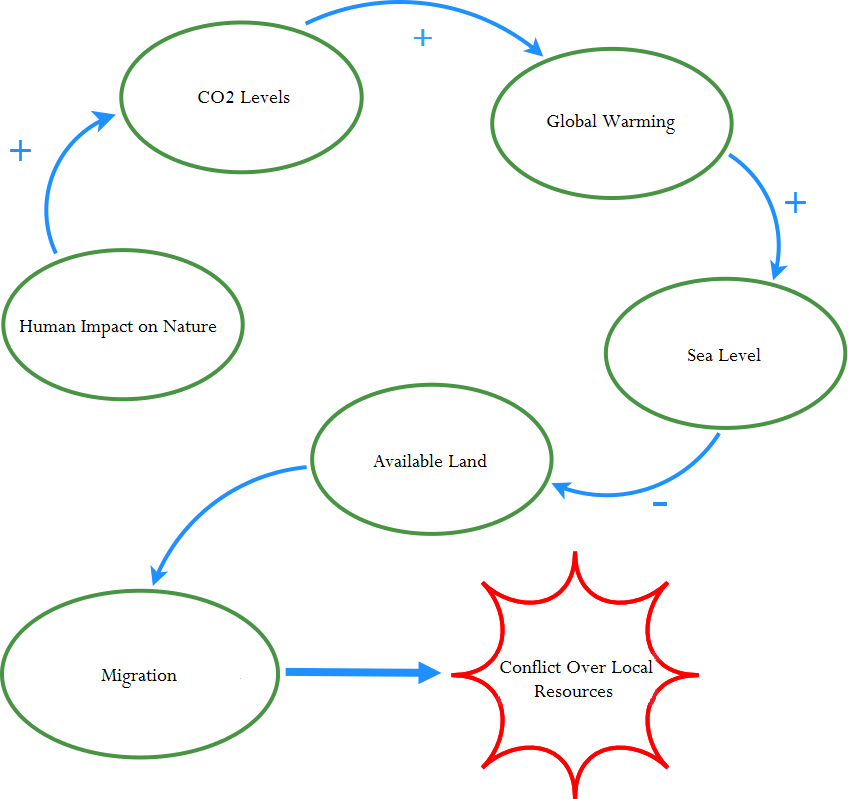 |
Figure 9: Casual loop diagram |
In order to better understand the dynamics of the conflict we can analyze it towards the casual loop presented on the figure 9. The casual diagram presents how the situation evolves since the impact of humans in nature until the conflict that might occurs between the Maldivian and the local population after the migration.
In this casual loop I considered the opinion defended by authors like James Lee, that the gases emitted by the increase of the use of fossil fuels since the Industrial Revolution were accumulated in the atmosphere and ended up causing the climate change (Lee, p. 51). Therefore, even though some authors defend that the climate change is just a normal cycle of earth, I agree with the idea that the human action was a catalyst for the process.
Following the arrows, the human impact promoted an increase on the levels of CO2 present in the atmosphere, which in turn was responsible for changing the global temperature, causing the global warming. Since the concentration of gases on the atmosphere creates a greenhouse effect, the world’s temperature rises. With this increase on temperature, the glaciers melt, creating an effect of sea level rising. The effect of the sea level rising is the decrease on land availability and resource scarcity, which forces the population of the areas affected to migrate. However, the climate change will affect the whole world, even though it will be in different ways. Therefore, conflicts between the two populations will be likely to occur.
One of the points that must be highlighted within the Maldivian situation is the fact that this situation has never happened before, thus, there is no path to follow in order to solve it yet. This includes the fact that the case of the Small Islands States population has different characteristics and that there is not a consensus about how to call the population that will be forced to migrate.
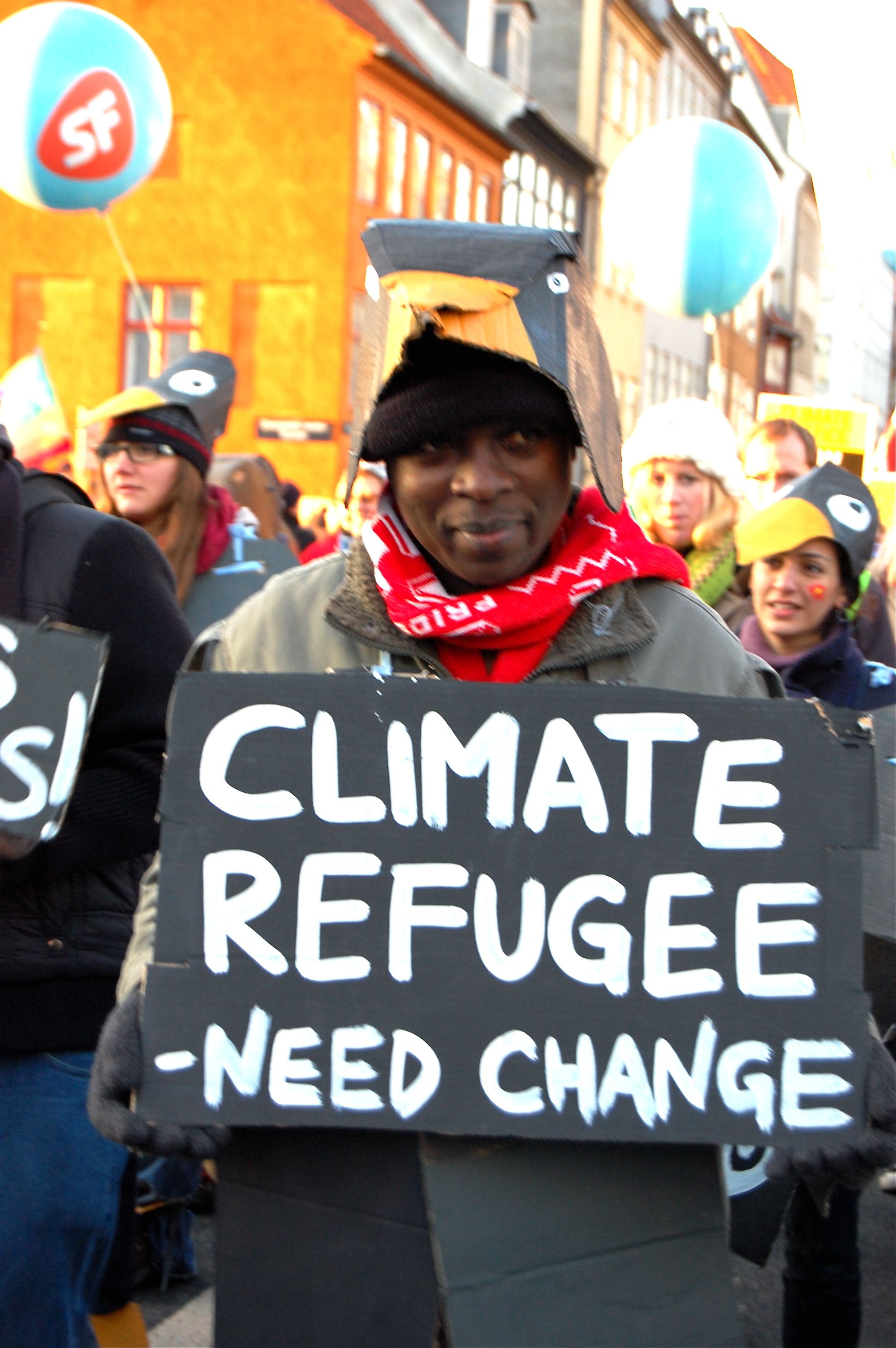 |
Figure 10: Manifestant claiming for change on the concept of Climate Refugee during the COP 15 |
With rare exceptions, in other cases of migration there is the strong propensity to return to their native territories (Werz and Conley, p. 13). However, in the case of the sea level rising and the Maldives Islands, come back to their territory will not be an option. As Burkett stated, “it is unclear whether displaced islanders will become stateless persons or landless citizens of a state that no longer exists”. The international law does not has any answer for cases where the state disappear and there is no successor state (Burkett, p. 5)
When we talk about the term environmental refugee, one of the definitions that we can work with is the one offered by Mike Myers:
“Environmental refugees are persons who can no longer gain a secure livelihood in their traditional homelands, because of environmental factors of unusual scope, notably drought, desertification, deforestation, soil erosion, water shortages and climate change, also natural disasters such as cyclones, storms surges and floods. In face of these environmental threats, people feel they have no alternative but to seek sustenance elsewhere, whether within their own countries or beyond and whether on a semi-permanent or permanent basis (Myers, p. 18-19).
However, the use of the term environmental or climate refugee has a series of legal and political implications, based on the definition of refugee defined under the 1951 Refugee Convention (Werz and Conley, p. 15). Using the term refugee can be seen as a way to add urgency to the situation; another term can end up downplaying the seriousness of the situation (IOM, p. 13). Besides the fact that the 1951 Refugee Convention has a restricted definition(2) of refugee, the term refugee implies a right of return that the Maldivian population will not have. Nevertheless, terms like climate evacuee or climate migrant are not good enough to characterize the situation.
Therefore, the Maldivian situation besides being a case of effects of climate change that might evolve to a violent conflict, it is an example of political and theoretical struggle in the international system. To solve the Maldivian situation we need first to reach a consensus on the term used to classify the population and to find a solution for their status as a population without country. However, there is a fear within the international system about giving any solution. Burkett affirms that “no state wants to be the first to offer a solution, for fear that it might be swamped by appeals from affected populations” (Burkett, p. 6).
What we can conclude is that because of the lack of consensus about the causes of climate change and the fact that it is not a problem that will occur in the short term, the international community is choosing to postpone the discussion and the solution for the situation. So, we can say that the situation is not in a high level of strategic interest to the international community as a whole, just for those who will be affected.
Finally, the outcome of the dispute cannot be predicted yet, since the situation of violent conflict is still just a forecast based on the information that we have nowadays. The many variables involved in the process do not allow us to predict the outcome of the situation. There are many possibilities that can happen.
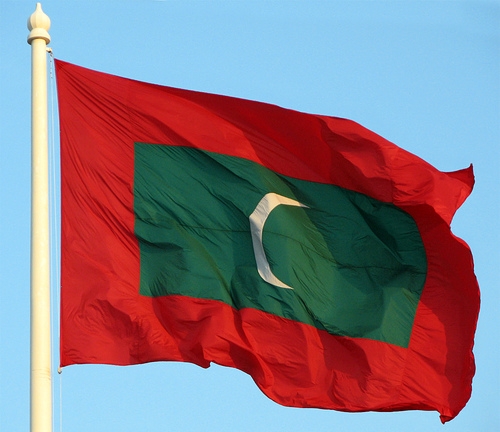 |
Figure 11: Maldivian flag |

(1) AOGCM is the acronymous to Atmosphere Ocean General Circulation Models which is the model used by the IPCC Third Assessment Report to obtain the data for the predictions of sea level rising (Woodworth, p. 15).
(2) The definition is: “a refugee is a person who owing to a well-founded fear of being persecuted for reasons of race, religion, nationality, membership of a particular social group, or political opinion, is outside the country of his nationality, and is unable to or, owing to such fear, is unwilling to avail himself of the protection of that country.” (IOM, p. 13-14).
KIRIBATI, Kiribati and Sea Level Rise, by Kimberly Ketchoyian
SOLOMON-SEALEVEL, Solomon Islands and Sea Level Rise, by Jessica Roberts
TUVALU, Tuvalu and Rising Sea Levels, by Jasmine Jones
Burkett, Maxine. “In Search for Refuge: Pacific Islands, Climate-Induced Migration, and the Legal Frontier”. Analysis from the East-West Center. No.98 January 2011. PDF File.
Evans, Alex. “Resource Scarcity, Climate Change and the Risk of Violent Conflict”. World Bank Development Report. 2011. PDF File. Apr 25, 2013.
International Organization for Migration (IOM). Migration and Climate Change. 2008. PDF File. Apr 25, 2013.
IPCC Fourth Assessment Report: Climate Change 2007. Available on: http://www.ipcc.ch/publications_and_data/ar4/wg1/en/spmsspm-projections-of.html. 23 April, 2013.
Lee, James R. Climate Change and Armed Conflict - Hot and Cold Wars. Routledge: New York, 2009.
Mimura, N., L. Nurse, R.F. McLean, J. Agard, L. Briguglio, P. Lefale, R. Payet and G. Sem, 2007: Small islands. Climate Change 2007: Impacts, Adaptation and Vulnerability. Contribution of Working Group II to the Fourth Assessment Report of the Intergovernmental Panel on Climate Change,M.L. Parry, O.F. Canziani, J.P. Palutikof, P.J. van der Linden and C.E. Hanson, Eds., Cambridge University Press, Cambridge, UK, 687-716
Muniruzzaman, Major General A.N.M. “Security Implications of Climate Change: A Case Study of Bangladesh”. NTS Policy Brief. No. PO13-02. Apr, 2013. Web. May 02, 2013.
Myers, Norman. Environmental Exodus: An Emergent Crisis in the Global Arena. The Climate Institute: Washington D.C, 1995
Republic of Maldives. National Adaptation Program of Action. Ministry of Environment, Energy and Water. 2006. PDF File
Salehyan, Idean. “From Climate Change to Conflict? No Consensus Yet” Journal of Peace Research. (2008) N. 3 Vol. 45: 315-326.
Sovacool, Benjamin K. “Perceptions of Climate Change Risks and Resilient Island Planning in the Maldives”. Mitig. Adapt. Strateg. Glob Change. (2012) N. 17: 731-752. Web. Apr. 18, 2013.
Werz, Michael and Laura Conley. Climate Change, Migration, and Conflict - Addressing complex crisis scenarios in the 21st Century. Center for American Progress. January 2012. PDF File
Woodworth, Philip L. “Have There Been Large Recent Sea Level Changes in The Maldives Islands?” Global and Planetary Change (2005) N. 49: 1-18. Web. 18 Apr, 2013.
